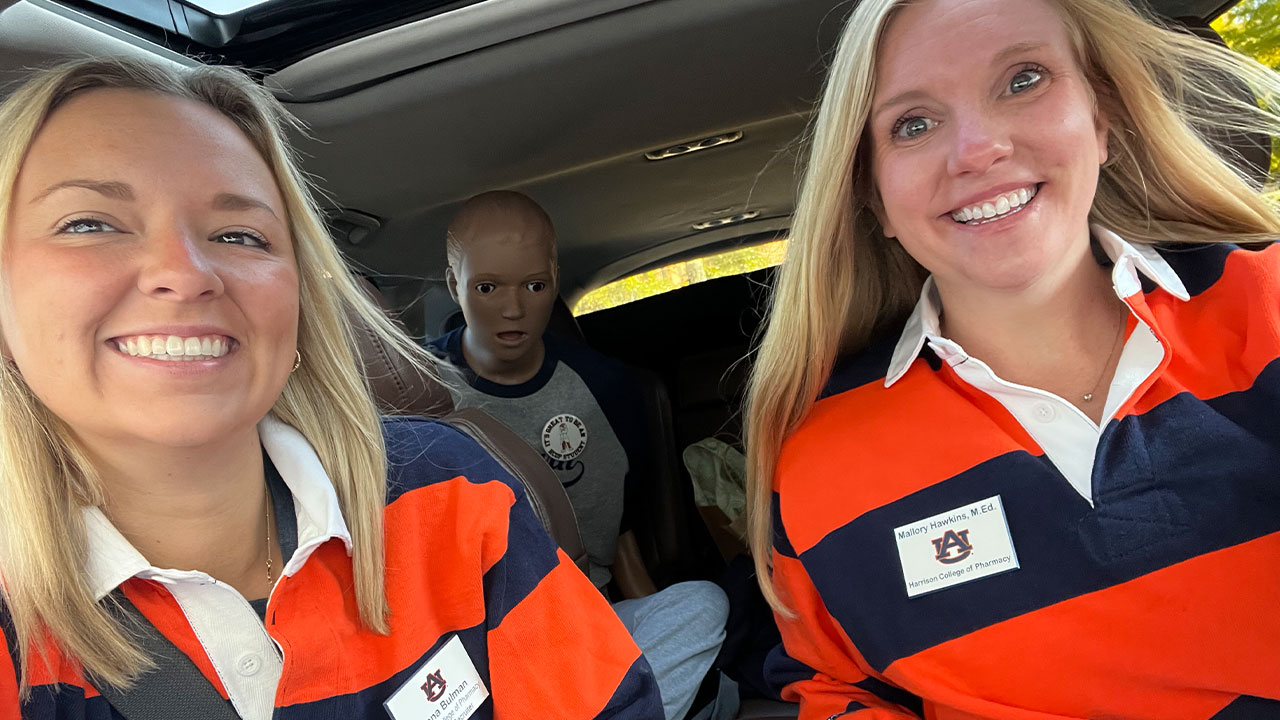content body
Recruiting young people — especially helping them understand what a pharmacy career actually involves — can be a challenge.
But Mallory Hawkins, director of student recruitment for Auburn’s Harrison College of Pharmacy, is reshaping how students perceive pharmacy careers with the help of an unconventional ambassador.
Walker — named for the W.W. Walker Building that houses the college — travels the state with Hawkins and a student recruiter, visiting high schools, summer camps and even Girl Scout meetings.
Dressed in Auburn apparel, Walker sits in the back of Hawkins’ vehicle. He sometimes rides shotgun — never in the trunk, though, as a mannequin, he probably wouldn’t mind.


Harry, Walker's 'brother,' works with the college's Center for Opioid Research, Education and Outreach.
Auburn Pharmacy overcame that hurdle thanks to last year’s Tiger Giving Day, surpassing its $7,500 goal to purchase two mannequins for recruiting and outreach.
While Walker travels with Hawkins, his “brother,” Harry — named for the James I. Harrison College of Pharmacy — supports the college’s Center for Opioid Research, Education and Outreach by helping with Narcan demonstrations at schools throughout the state.
On tour
Hawkins, who joined Pharmacy four years ago and added Walker just last year, sees how bringing Walker to students — in gyms and lecture halls — leaves a lasting impression.
She may deliver the same message about pharmacists in a traditional presentation, but with Walker by her side, they “bring pharmacy to life.”
“Using Walker creates a visual and hands-on experience that makes pharmacy careers more relatable, especially for younger audiences who may not know what pharmacists do,” she explained.
A key goal for Hawkins is to shift perceptions. Pharmacists do far more than fill prescriptions; they also provide clinical care, interact with patients and solve complex problems.
Hawkins illustrates this with activities like a patient-care relay, where students diagnose Walker’s symptoms and match him to the right treatment, or role-playing as pharmacists during his “visit” to the pharmacy.
“We use him in everything from a game of ‘Pokémon or Drug?’ to interactive stations showing how pharmacists assess patient needs,” she said. “We’ve worked with students ranging from fourth-grade Girl Scouts to pre-health undergraduates, tailoring each experience to the audience.”
Difference maker
Walker always makes an impression. He turns heads riding shotgun and has “scared more than a few staff members” in the office, Hawkins said.
“We honestly talk about him like he’s one of us,” she admitted. “His presence never fails to get a laugh, and honestly, we could all use a dose of that.”
No pun intended.
One of Hawkins’ favorite moments happened after a school presentation.
“I looked over, and the entire class was huddled around him, taking a selfie,” she said. “It made me smile — it perfectly captured what I hope to create: a space where students feel comfortable being themselves.”
For Hawkins and her student recruiters, Walker is “a built-in icebreaker.”
“He turns any presentation into an engaging, memorable experience,” she said. “Students visualize their future roles now, and they leave with stories to tell.”
In just a year, Hawkins has already witnessed his impact.
“We’re seeing increased engagement at our events — students ask more questions, remember the scenarios and follow up for more information about pharmacy careers or our summer programs,” she said. “The novelty and humor of Walker help lower barriers and make professional health education feel approachable.”
This fall, Hawkins and her team will start surveying students, using the results to gauge any refinement to the approach with Walker.
Coming Sept. 10
The Harrison College of Pharmacy's 2025 Tiger Giving Day project will focus on the War Eagle Wellness Clinic — a free, student-run community clinic.Next steps
Walker will soon debut “Walker’s World Tour: An Unforgettable Learning Experience” with each stop highlighting a different role pharmacists play, from ambulatory care to emergency medicine.
Hawkins said she and her team are developing a toolkit — with scenarios, setup guides for different age groups and sample devices like an inhaler or EpiPen — so others can replicate the model with their own mannequins.
Additionally, they are working on expanding scenarios with Walker to highlight teamwork in health care, such as assigning students different roles — pharmacist, nurse, physician and social worker — and playing out a situation together.
“It will give them a glimpse into collaborative care and help teach the interprofessional communication that’s essential in health care today,” Hawkins added.
As Walker embarks on his first “world” tour, he’s proving to be more than a prop — he’s a spark for curiosity, a tool for learning and a symbol of how a little creativity can transform outreach.








